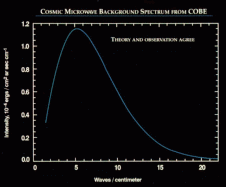36.2 The Cosmic Microwave Background
- There is additional evidence for the Big Bang besides the observed expansion of the Universe.
- Because all of the observed mass and energy in the Universe must have been initially concentrated in a very small space, the mass/energy density must have been very high, which means a very high temperature, hotter than the interior of any star.
- At these temperatures, most of the mass/energy existed in the form of high-energy gamma radiation. These photons interacted with each other and with other particles, gaining and losing energy as they collided, resulting in a variety of wavelengths with a blackbody distribution.
- As the Universe expanded in size, the mass/energy density decreased and the temperature dropped. The blackbody spectrum must have therefore shifted its peak to longer wavelengths as well, as described by Wien's law:

- Now, 13 Gy later, the photons have shifted to low-energy microwaves.
- This radiation is known as the cosmic microwave background. Its existence is not predicted by any other theory of the Universe.
 It was discovered by Penzias and Wilson at Bell Labs in the early 1960s; they were working on a microwave antenna to relay telephone calls to communications satellites, and found a background noise with a peak wavelength around 1 mm, corresponding to T = 3 K. It was discovered by Penzias and Wilson at Bell Labs in the early 1960s; they were working on a microwave antenna to relay telephone calls to communications satellites, and found a background noise with a peak wavelength around 1 mm, corresponding to T = 3 K.
- The Cosmic Background Explorer (COBE) satellite was sent into orbit in 1989 to measure the background radiation; it was found to be a perfect blackbody spectrum for T = 2.735 K.
- COBE also found that the background is almost perfectly isotropic.
- There do exists slight anisotropies, however . For one thing, the radiation is slightly "warmer" (blueshifted) in the direction of the constellation Leo, and "cooler" (redshifted) towards Aquarius. The following image is a projection of the entire sky, with the Milky Way horizontal across the middle and Sagittarius in the center. (Note: the colors are actually the reverse of what might be expected; Leo is in the red region at the upper right and Aquarius is in the blue region at the lower left.)
- This smooth variation in the background radiation is due to the motion of the Earth with respect to the background.
In the direction we are travelling a blueshift occurs (the same as if we were standing still and it moved towards us).
- Analysis of the data indicates that we are moving at a speed of 390 km/s towards Leo.
- Taking into account our motion around the galaxy (horizontally to the right), this means that the entire galaxy must be moving at a speed of 600 km/s in the direction of Centaurus, somewhat closer to the center of this figure (in the green).
- We are pulled in that direction by the gravitational force of several nearby galaxy clusters (including the Virgo Cluster), and a gigantic supercluster called the Great Attractor.
- When the motion of the Earth is accounted for, remaining fluctuations in the background radiation are still found, although they are at most 100 µK warmer or cooler than the average:
- These variations are believed to be due to concentrations of mass in the early universe, which prevented complete isotropy of the background radiation by gravitationally redshifting it (regions of greater density appear blue here).
This mass eventually condensed into the superclusters, clusters, and galaxies we now observe.
|